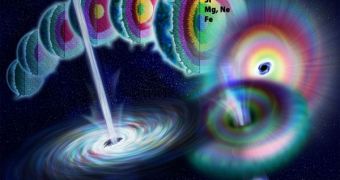The UWA Zadko Telescope, owned by the University of Western Australia, was the first one in the world to capture the massive Universe event that saw a giant star collapsing into a black hole and emitting a massive gamma ray burst , fortunately for us in a very distant galaxy. The emission is believed to be about 11 billion years old, and is visible only now because of the time the light needed in order to travel from the site of the collapse to our planet. Australian astronomers say that, if such an explosion were to happen in a place nearer to us, all life on Earth would undoubtedly go extinct.
"As if seeing one of the biggest explosions in the universe wasn't dramatic enough, we had a catastrophic computer crash on the night. We had nothing to record the images with, so team member Timo Vaalsta used a cheap video camera instead of the sophisticated astronomy camera that wasn't working," UWA Senior Research Fellow Dr David Coward, the leader of the Zadko Project, says.
"The image we recorded is a window in time, allowing us to peer into the distant past to a time when the universe was very exotic. We are discovering the richness of this transient universe, one that is filled with brief but extremely bright flashes," the scientist adds.
Surprisingly, the team were able to detect the burst some time before the European Southern Observatory got a hold of it, but was unsure of what they had captured, so they kept it to themselves, and only notified NASA in December. The American space agency then sent the data to all observers on the planet. Now, everyone in the community knows that the Zadko telescope was the first to detect the rarest of this kind of events – the collapse of a bright star into a black hole.
According to the readings registered by several Earth-based observatories, the explosion that accompanied the collapse was about a billion times brighter than that of our Sun, which would explain why UWA researchers argued that, if the explosion were to happen in our galaxies, the effects would have been catastrophic for countless solar systems, including our own.
Now, as part of a new project, Zadko is directly connected to a global network of telescopes, coordinated by NASA's Swift satellite ground station, which means that it can be remotely orientated to points of interest in the skies.
“Another key aspect of the project is to encourage high school participation in the research. It is likely that high school students could, as a result, contribute to tracking dangerous near-Earth asteroids. In partnership with the Western Australian Department of Education, the UWA Zadko Telescope Project is committed to enhancing science education," professor Alan Robson, Vice-Chancellor at UWA, concludes.

 14 DAY TRIAL //
14 DAY TRIAL //